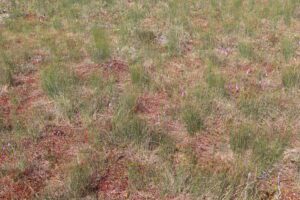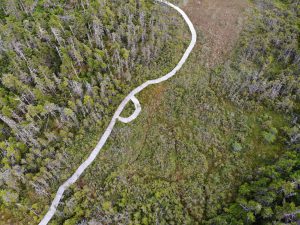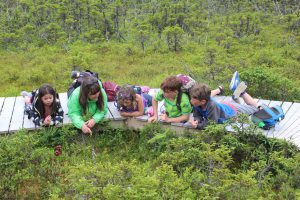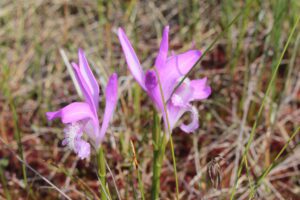By Laura Temple
Why, you may ask, did we choose the name “From the Dragon’s Mouth” as the name for this blog?

A Dragon’s Mouth Orchid
Dragon’s Mouth Orchid, or “Arethusa bulbosa” is a species that brings a fuschia hue to bogs across most of the island of Newfoundland in the summer–though not as far north as Northern Peninsula or Labrador. It also grows in bogs and boreal forests in Eastern North America.

A bog with scattered fuschia orchids
Like all orchids, the flower is bent at a 90-degree angle–the process by which it moves into this shape is called resupination. This particular orchid also has a spotted ‘tongue’ and yellow ‘fire’ in its mouth.
In July, when these orchids are scattered throughout bogs, they appear like tiny heads with their mouths wide open, as if speaking (and bog is similar to the word blog, get it? ;)). This, combined with a play on the phrase “from the horse’s mouth” is where this blog got it’s name.
Glaciers and orchids
The very first time I really noticed this orchid was during a canoe trip at Echo Pond. A group of volunteers and I were scouting out canoe route options for summer camp, which involved portaging through a bog that connects two ponds. Some of the people on the trip casually shared knowledge about the landscape as we went, pointing out glacial features, like moraines, and commenting on how the glaciers had made this landscape ideal for canoeing.
Another volunteer brought our attention to something much closer to us and much smaller. The Dragon’s Mouth Orchids were in bloom and were narrowly missing our footsteps. The volunteer had recently learned about the seeds of the Dragon’s Mouth Orchid—that they only produce one seed capsule per year. The capsule contains hundreds of minuscule seeds, but very little stored food or nutrients. Therefore, the seeds are dependent on a type of fungus that grows near the parent plant to provide nutrients to these tiny seeds. In addition to this, I later read, this type of orchid does not have any nectar. They rely solely on their appearance to attract pollinators. For this reason, it’s just the young, immature pollinators that visit, until they learn the difference.
I stepped much more carefully after this, more aware of the small beings, and respecting what it took for them to exist here at all.
This conversation on the bog struck me—the contrast between imagining a landscape covered in enormous, rock-demolishing glaciers, and now left behind in its path, this seemingly fragile flower. There was a much longer history here than met the eye. As usual, there were so many hidden stories unfolding in the land we walked through.
Dragon’s ‘Tongue’ Bogwalk
I was intrigued after this conversation and began to look more closely at the flowers on the bog nearer the Centre, which we had named the Dragon’s ‘Tongue’ Bog (due to a small miscommunication!). The bogwalk had been there before the canoe trip I described above, but it took the story about the orchid seeds for me to really start paying attention to them.

The bogwalk from above (photo cred: TA Loeffler)
The ‘bogwalk’, a project envisioned and carried out by Helen Spencer and a team of volunteers, was created to give children and young people that visit the Centre a closer look at the bog, with the hope that they develop a deep appreciation for the value of this ecosystem and the species it is home to. Because of this bogwalk, I also got the chance to get up close to many tiny trees and unique flowers, and to realize how much I personally love bogs. And I’ve seen many small, curious faces gaze in wonder at this amazing ecosystem too.

Katie Harrison, Camp Director, pointing out bog species to camp kids
*
Lots to learn from the Dragon’s Mouth Orchid
In addition to the more obvious reasons for the name of the blog, I think there are several things that this special plant teaches, that resonate with what is so special about the Echo Pond Environmental Education Centre.
Interrelationships and working together
Like the hundreds of tiny seeds that can only grow with the help of fungus in the soil, this orchid is dependent on relationships and has an entire community behind its being able to survive and thrive, and much of this goes on behind-the-scenes.
It’s a reminder to be grateful, even for the work being done that is not immediately obvious. Whether it’s someone building a bogwalk that allows you to see plants up close, the organizing that teachers do to get their students to the Centre, or the months of thoughtful planning that goes into summer camp.
Resilience
This orchid appears so fragile, yet survives season after season in the damp bog–their many tiny seeds making the way for another new season. It’s inspiring to think about the resilience and persistence that helps us work through challenges, whether it’s a global pandemic, or any number of changes that have come up over the past 40 years of being in operation.
The curiosity of the young
The Dragon’s Mouth Orchid’s existence is dependent on the youthful inexperience of bees. It’s an adaptation to a relationship with young bees. The bees will always have to learn for the the first time that they will not find nectar in the flower.
It’s a reminder that there will always be new young people discovering nature, feeling awe, and experiencing wonder for the first time (though hopefully, they are discovering sweetness when they get into nature—no analogy is perfect ;)).
*
All this to say: a lot can be learned from a flower and we hope you enjoy our blog!

Dragon’s Mouth Orchids in the Dragon’s ‘Tongue’ Bog